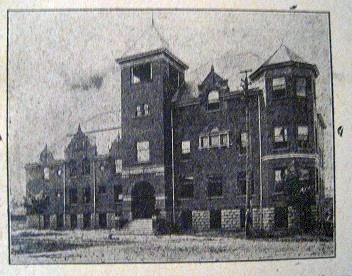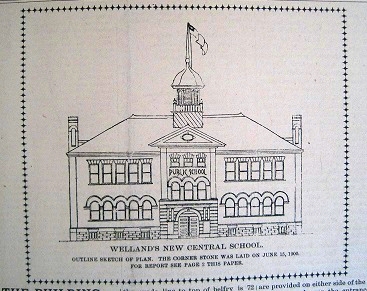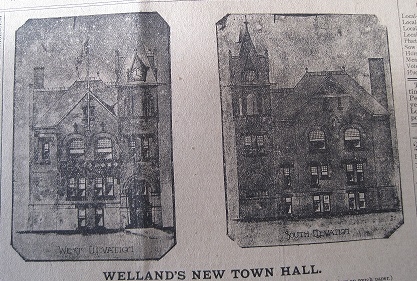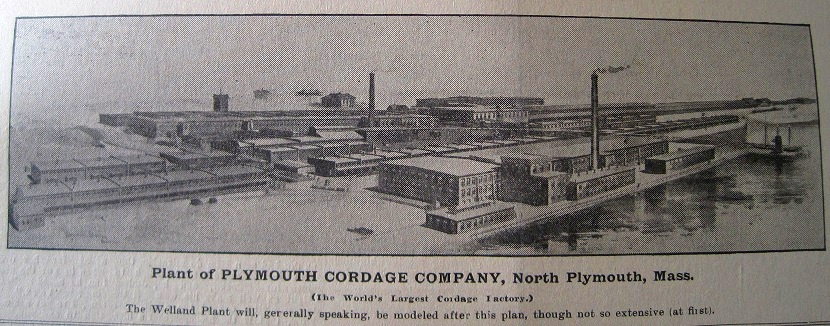Results for ‘Businesses’
[Welland Tribune, 29 April 1898]
To the Welland Tribune:
Your correspondent this week paid a visit to “Maple Grove” the extensive fruit farm of William Platts & Sons. The firm is composed of Wm. Platts, sr., Earnest, A.P. and William , jr. Their farm is the land of the late Samuel Rice and is situated in the picturesque village of Pelham Corners, and is adjacent to the celebrated Fonthill nurseries. We found Mr. Platts busily engaged in planting 9 acres of strawberries. They have 11 acres of last year’s planting, making in all 20 acres of strawberries. They are testing several new varieties, such as the Beeder Wood, Bon Ton, Bubach. But the Williams seems to take the lead as to hardiness, good growth and fruiting. They have 15 acres of fine, red raspberries and from present appearance will turn out well. Last year the insect did considerable damage to the foliage, but the plants have entirely recovered from the effects of their ravages. The 4 acres of blackberries look well and will no doubt yield heavily. They have 10 acres of fine orchard on the Bridgman farm in Thorold township, composed mostly of Baldwin, greenings and spies, and it is well trimmed and in good shape for a crop this year. There is also a fine pear and plum orchard on the Bridgman farm and a nice lot of grape vines.
The Messrs. Platts are great potato growers, and they usually plant from 25 to 30 acres. Last season the weather did a great deal of damage to their crop, but Mr. Platts is thinking perhaps this will be a more favorable year, and will plant the usual amount. Their chief market for potatoes is Thorold and Merritton, and they take large loads to these markets three times every week from the time the early ones are fit until all are sold right from the field, thus saving the additional cost of putting them in pits or the cellar. Their loads often average from 70 to 100 bushels. That is late in the fall. Earlier in the summer their loads will run 20 to 40 bushels to the load. They supply all the bakeries and nearly all the large dealers the whole summer. This spring the firm is trying a new experiment in potato growing, viz: Plowing three furrows and dropping a whole potato about two feet apart in the furrow, and then plowing three more furrows, dropping again, and so on until a field is finished, and put on the disc harrow and work up the ground well on top, and just about the time the potatoes begin to show through the ground, they go on with the weeder, purchased from R. Moore & Son. This weeder is an implement similar to a sulky horse rake, and does splendid work. Last year the weeder saved a lot of labor in cultivating, hoeing, &c.
In stock they have 10 horses, 50 sheep, several cows and 30 heads of hogs. Last fall the firm built a large hog house (not as expensive as the Humber one) and purchased several brood sows and they lately added an imported O.I.C. hog from the celebrated herd of John Stirtzinger. They intend to turn the hogs in a large clover field as soon as it is fit, and thus raise their pork at a nominal cost, as it does not pay to produce pork from grain alone. The O.I.C. breed of hogs seem to be taking the lead as a good selling pig at six month’s growth.
The old-fashioned way of cutting feed and chopping grain by horse-power was too slow for Mr. Platts, so they purchased a Chicago aermotor windmill from Mr. Johnson of Ridgeway, and it does first class work, chopping all their own gain besides doing considerable custom work for the neighbors.
Mr. Platts, sr., takes a deep interest in religious work, and is pastor of the society of Adventists, and he preaches every Sunday in Dalton’s Hall, Fonthill, to large congregations.
[Welland Tribune, 24 August 1900]
A large two-storey addition, about 20×30, is being erected to the Welland evaporator by Contractor Ellsworth, to be used as a dryer. The drying ovens did not give good satisfaction last year, and the new building is to do their work. It is constructed on the latest improved plan. The ground floor contains the furnaces, and the heat ascends through the upper floor, which is really a drying rack, being constructed of inch square strips laid a quarter of an inch apart and on which the apples are laid.
MACHINERY SHIPMENTS
The firm of M. Beatty & Sons are doing an exceptionally large business in hoisting engines this year, having already sold many more than were made in any previous year. The number sold to date is twenty-nine. A carload of three was shipped this week to M.P. Davis for the Quebec bridge work. This was the second carload to him, the first having been shipped to Mr. David last week. The week before engines were sent to the Engineering & Contracting Co., Chaudiere Jct., Quebec, and Canadian Rand Drill Co., Quebec.
Many residences Building
[People’s Press, 29 August 1905]
The building boom is beginning in earnest in Welland, in fact, by the amount of building now in progress or nearly completed, has evidently been on for some months past
F. Rounds of the Northern Lumber Yards has commenced building operations on a planing mill at his yards, North Main street. The new mill is located just north of his old saw mill building, and will be a one-storey fire proof building with cement floor and walls. The main building will be 22×60 feet with engine room in addition. Mr. Rounds will install the most modern machinery. The old sawmill will be dismantled and used as a store house, for which it is admirably adapted.
A summing up of residences now in course of construction reveals a substantial increase.
Mrs. McEwing has just started a nice residence on East Main street.
J.H. Burgar has about completed the rebuilding of his residence on Muir street, in the most modern style. The house has been greatly enlarged, and a cellar built underneath the whole building.
Alex Griffiths has just about completed a handsome residence on Division street, near the G.T.R.
T. Roach has also built a fine large frame residence on Division street, next to the Episcopalian church, which is about ready for occupancy.
H.W. Somerville is building a stylish concrete residence on Merritt street.
Mrs. Mary A. Tait is completing a modern frame residence, also on Merritt street.
J. McMillan has been rebuilding a residence on Hellems avenue in a neat manner.
A.J.J. Brennan has let the contract to R.M. Jamieson and M. Vanderburg for a brick residence on Young street, and Mrs. O.H. Garner has let the contract to R.M. Jamieson for a residence on Griffith street. There are more houses in construction than this, besides numerous improvements and additions to residences, so that the building trade is livelier than for many years. What will it be when the Cordage and Beatty factories boom is fully on?
Watch Welland grow.
[Welland Tribune, 2 April 1907]

The above is a picture of the Stratford Y.M.C.A. The building is one of the finest of the kind in Canada, and the work carried on under the direction of the secretary, J.W. Ward, shows many evidences that the Stratford institution is fulfilling in a splendid measure the purposes for which it was intended.
The Y.M.C.A. is new in Welland, and, by the size of the town, it is restricted in membership and some of the details of the work, but it has come to stay. To those on the role of membership and to those others who have earnestly supported the enterprise a description of the Stratford Y.M.C.A. will be of interest.
The building shown in the picture was erected at a cost of $25,000 and was opened two years ago. The Grand Trunk Railway which operates large shops at Stratford gave the site for the building and this includes as well an area in the rear for bowling, tennis and baseball. The railway company as well gave a liberal subscription toward the building fund.
The building seems to have everything that should belong to a well-appointed and equipped Y.M.C.A. The parlor and social room is as inviting as a place could be; the business office has all the accessories.
The library has three thousand volumes. There are three reading rooms, a general, a boys’ and one for the railway men who are permitted to hit the pipe as they pour over books and magazines.
A splendid gift to the institution was that made by William Battershall-swimming tank 35×24, six shower baths and stalls of Italian marble and two tub baths.
The Y.M.C.A. is interesting, however, chiefly for what it does. J.H. Moffatt, one whose name is well-known in the furniture trade, gives lessons in furniture designing. A night school is conducted by George W. Slaughter, the work embracing the most elementary arithmetic on the one hand up to matriculation on the other. Music is taught by L.R. Bridgman.
The boys have a place all to themselves down stairs, where they conduct a King Arthur’s Round Table Club. They have mock courts and trials, councils and parliaments.
A leading factor in the sport of Stratford is the Y.M.C.A: Basketball, hockey, baseball and football are centred about the institution.
[People’s Press. 19 June 1900]
 The new school building when completed will be a handsome brick structure covering an area of 91 feet 3 in by 53 ft. 9 in., with a projecting entry in centre front 14 by 25 feet. It is situated on a three acre plot of land between Division and Young street, also partially bordering on Hellems avenue. The building faces north and is in line with Cross street, so that a fine view is obtained from that street as well as from the town hall square on Main street. The front of the building is about 200 feet back of and facing the Division line, and a concrete walk, dividing a lawn, with flowers and shrubs, will lead from the street to the entrance. In the rear of the building are ample ply grounds.
The new school building when completed will be a handsome brick structure covering an area of 91 feet 3 in by 53 ft. 9 in., with a projecting entry in centre front 14 by 25 feet. It is situated on a three acre plot of land between Division and Young street, also partially bordering on Hellems avenue. The building faces north and is in line with Cross street, so that a fine view is obtained from that street as well as from the town hall square on Main street. The front of the building is about 200 feet back of and facing the Division line, and a concrete walk, dividing a lawn, with flowers and shrubs, will lead from the street to the entrance. In the rear of the building are ample ply grounds.
The total height of building from the grade line to top of belfry is 72 feet, and to the point of flag pole 88 feet.
An arch of masonry will overhang the front entrance to the building. The porch opens into a vestibule 6×9, from which stairways lead both to basement on the right and main hall on the left. The main halls extend through the centre from front to back, and are 25 feet in width. In the centre of both halls is to placed a drinking fountain, around which the walls form an octagon about 21 feet in width. There is also a rear entrance to the building which leads similarly in to both basement and ground floor. On each floor are four commodious class rooms, each 25 x33 feet. All are well lighted and so arranged that the principal source of light is from the pupil’s left. Convenient cloak rooms for the teacher are provided on either side of the main entrance, and over the entrance, on first floor, is a room 10 ft. 6 in. by 21 ft. 6 in. set aside for the use of the board of trustees. In the basement are two large play rooms, each 24×32 feet, and in the rear of these are the furnaces and modern toilet room. The system of ventilation is most complete, the furnaces being guaranteed to completely change the air of the entire building three times per hour. The flooring to be of maple throughout. The plans and specifications of the structure were drawn by J.E. Ellis, architect, of Toronto, and the contracts have been let to Jacob Lovell (carpenter work); M. Vanderburg (masonry); Pease Furnace Co. (heating). The total cost of the building & c., will be about $14,500, exclusive of the land.
(The unusual shades in the half-tones are due to the fact that they were reproduced from the architect’s colored drawings on rough paper.)
[People’s Press, 24 July 1900]

The above cuts represent the outline of the town hall building about to be erected on the market square, Welland, and for which the contracts have been signed by the successful tenders, Messrs. M. Vanderburg and J.E. Cutler. The contract price was $7020.
The building will be a handsome ornament to the town, and will be situated in the most conspicuous location. The structure will be of brick. The dimensions are 46×60 feet and the height of the tower from the ground line will be 76 feet. The ground and first floors will be furnished throughout in quarter-cut oak, and the basement is clear white pine. The height of ceilings will be: Basement 8 feet 6 in., ground floor 11 ft. and first floor 15 ft.
The front part of the basement is arranged for the night watchman, with a cell on the northwest corner. The balance of the basement 42 ft. 9 in., by 35 ft., is to be open for the convenience of marketers, as a basket room etc.
On entering the ground room there is a spacious hall, from which entrance is had to the treasurer’s office in the front, the clerk’s office on the north side, and the public library and reading room in the rear. The treasurer’s office will be divided into two compartments, 13 ft. 6 in. by 8 ft. 9 in., and 11 ft. 6 in., by 11 ft. 3 in., with a vault over the cell. 19 ft. by 15 ft. 6 in., are the dimensions of the clerk’s office. The library room is 17 ft. 3 in., by 15 ft. and the reading room 17 ft. 3 in., by 24 ft. 6 in.
A balcony extends out over the front room from the first floor. The front portion of the upper room, 42 ft. by 26 ft. 6 in., is to be a council chamber, and the balance for the use of the firemen. The fireman’s apartments will be divided into three parts-one room 13 ft. by 17 ft. 3 in., another 23 ft., 6 in., by 17 ft. 3 in., and a wardrobe between the two. There is a lavatory off the hall between the council chamber and firemen’s room.
The building will be heated by natural gas, and is to be completed by Nov. 1st.
REAL ESTATE
FOR SALE IN TOWN OF WELLAND-the desirable and centrally located premises on the corner of Hellems ave. and Division street, known as the “Guest property.” Two dwellings, shop, barn, etc. A great bargain-small payment, down and monthly payments, if desired. Apply T. MAIN, Welland.
Cordage Company Competes Purchase of all the Lands Under Option-$20,650 Paid Over-Exact Sites of Structures not yet Decided on.
[Welland Tribune, 18 August 1905]

According to announcement previous to the passing of the by-law, the officers of the Plymouth Cordage came to Welland this week, and completed the purchase of all the lands under option by them, viz., about 180 acres, paying therefor the sum of $20, 650, The lands purchased are as follows:
The McCoppen farm (formerly owned by Mr. Westward), 50 acres; price, $6,250. This includes the dwelling house formerly occupied by Mr. Westward.
The John Leitch farm, 63 acres; price, $6,000.
R. Morwood, estate farm, 50 acres; $4,500. This lot lies in the rear of the McCoppen property (calling Muir street or the canal the front.)
J.D. Gunn, a number of lots; comprising about 17 acres; consideration, $3,900. This property lies between Muir street and the canal, and between Mr. Boyd’s residence and Rice’s planing mill, fronting on both Muir street and the canal, eligibly situated hence the higher price than the other property
The following were here in connection with the matter; President Loring, Homes, sr. and jr., treasurer and assistant; Mr. T.S. Hobbs, Ontario representative, and Mr. Lindsay of Lindsay Bros., Milwaukee, representatives, all of the Cordage Co., and also M.C.C.R. Engineer Sharp and other M.C.R.R. officials.
The exact locations of the buildings has not yet been decided upon, and upon this will depend the manner in which the switch connecting with the railways will be put in. The Co. would have liked to buy the block of land lying between Muir street and canal, and between their present site and the M.C.R.R. tracks, including the sites of Rice’s mill, McCoppen’s hotel, etc., but the lands were held at too high prices. Did they own this block the switch could have been brought from the railroad along the canal, without the necessity of crossing Muir street. As an alternative it is possible the main factory buildings may be placed on the Westward farm (east side of Muir street) and the warehouses on the west side of Muir street.
Mr. Frank Holmes will be the company’s manager at Welland.
The town council at a special meeting Wednesday evening passed a by-law empowering the company to construct a switch connecting their factory with the railways.
The Cordage Co., party made their headquarters at Niagara Falls, driving to Welland and returning on Tuesday and Wednesday. Whilst at the Falls they negotiated with the Ontario Power Co., for power for the Welland works.
Mr. Howard, the company’s engineer, started at work again yesterday, and just as soon as the preliminaries of railway connection, building contracts, etc., can be arranged, work will be begun and pushed with the utmost vigor, to begin manufacturing in December if possible.
Line Runs Direct East From Welland to The River-Bridges Are to Have Foot-and Carriage-Way
[The Welland Tribune and Telegraph, 1 February 1921]
There was filed in the Welland Registry office last week the land plans of the Niagara Bridge Co., and it is one of the most important and interesting railway documents the registry office has seen in many years.
The bridge company will not only span the Niagara River but as well will construct and own a railway which will connect the Michigan Central System at Welland with the New York Central System in New York State.
The new line will tap the Michigan Central, just east of Welland, at a point half a mile north of the Cook’s Mills Road. The direction is direct east striking the river about two miles north of Black Creek. The line crosses the first bridge to Grand Island at Sheerwter Park.
The company has purchased two Willoughby farms at the approach to the bridge and the rest of the property for right of way will be acquired under the railway act.
The Tribune and Telegraph understands the M.C.C.R., C.P.R., and T.H.&B., jointly control the new company. The plans were filed by E. D. Cahill, solicitor for the T.H.& B.
It is of great interest to note that the company is required under its charter to maintain a foot and carriage-way on the Niagara River Bridges.
[The Welland Tribune and Telegraph, 28 January 1921]
The Welland Business College having assigned its lease, 275 Main St. East, to the G.W.V.A., will on Monday, January 31, occupy its new home, 45 Main St. West (Rogers Block). These new premises have been specially fitted for our work. We are no longer a speculation. We have proven our ability and are in Welland to stay. W.G. Charlton, Principal.
Portion of Road Will be Inundated When New Canal is Built
[People’s Press, 25 February 1919]
Although the matter of the city lending assistance to the county to a material extent regarding the construction of the River Road leading West from the city into Wainfleet, was referred at the last council meeting to a committee for investigation and further report, Mayor Brennan informs the Tribune that the proposed scheme was not favorably discussed by the members of the council. It was proposed that some $10,000 be spent on the construction of the road, but as the two or three miles of this road nearest the town will be inundated with six feet of water when the new canal is built, it is not considered by members of the council that it would be good business to spend any city money upon the road at this juncture.
Through a misapprehension it was stated in the TRIBUNE that the price to be paid for the fire hall site on the north-east corner of Hellems Avenue, and Division was to be $12,000. The cost of the property is only $8,000. The site comprises 100 feet on Division street, and 132 feet on Hellems Avenue.
 Subscribe..
Subscribe..

 The new school building when completed will be a handsome brick structure covering an area of 91 feet 3 in by 53 ft. 9 in., with a projecting entry in centre front 14 by 25 feet. It is situated on a three acre plot of land between Division and Young street, also partially bordering on Hellems avenue. The building faces north and is in line with Cross street, so that a fine view is obtained from that street as well as from the town hall square on Main street. The front of the building is about 200 feet back of and facing the Division line, and a concrete walk, dividing a lawn, with flowers and shrubs, will lead from the street to the entrance. In the rear of the building are ample ply grounds.
The new school building when completed will be a handsome brick structure covering an area of 91 feet 3 in by 53 ft. 9 in., with a projecting entry in centre front 14 by 25 feet. It is situated on a three acre plot of land between Division and Young street, also partially bordering on Hellems avenue. The building faces north and is in line with Cross street, so that a fine view is obtained from that street as well as from the town hall square on Main street. The front of the building is about 200 feet back of and facing the Division line, and a concrete walk, dividing a lawn, with flowers and shrubs, will lead from the street to the entrance. In the rear of the building are ample ply grounds.
